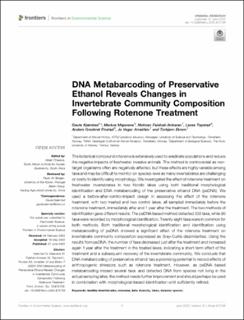| dc.contributor.author | Kjærstad, Gaute | |
| dc.contributor.author | Majaneva, Markus | |
| dc.contributor.author | Falahati-Anbaran, Mohsen | |
| dc.contributor.author | Topstad, Lasse | |
| dc.contributor.author | Finstad, Anders Gravbrøt | |
| dc.contributor.author | Arnekleiv, Jo Vegar | |
| dc.contributor.author | Ekrem, Torbjørn | |
| dc.date.accessioned | 2022-08-12T10:42:50Z | |
| dc.date.available | 2022-08-12T10:42:50Z | |
| dc.date.created | 2022-06-20T13:53:27Z | |
| dc.date.issued | 2022 | |
| dc.identifier.issn | 2296-665X | |
| dc.identifier.uri | https://hdl.handle.net/11250/3011586 | |
| dc.description.abstract | The botanical compound rotenone is extensively used to eradicate populations and reduce
the negative impacts of freshwater invasive animals. The method is controversial as non target organisms often are negatively affected, but these effects are highly variable among
taxa and may be difficult to monitor on species-level as many invertebrates are challenging
or costly to identify using morphology. We investigated the effect of rotenone treatment on
freshwater invertebrates in two Nordic lakes using both traditional morphological
identification and DNA metabarcoding of the preservative ethanol DNA (peDNA). We
used a before-after-control-impact design in assessing the effect of the rotenone
treatment, with two treated and two control lakes, all sampled immediately before the
rotenone treatment, immediately after and 1 year after the treatment. The two methods of
identification gave different results: The peDNA based method detected 333 taxa, while 90
taxa were recorded by morphological identification. Twenty-eight taxa were in common for
both methods. Both traditional morphological identification and identification using
metabarcoding of peDNA showed a significant effect of the rotenone treatment on
invertebrate community composition expressed as Bray-Curtis dissimilarities. Using the
results from peDNA, the number of taxa decreased just after the treatment and increased
again 1 year after the treatment in the treated lakes, indicating a short-term effect of the
treatment and a subsequent recovery of the invertebrate community. We conclude that
DNA metabarcoding of preservative ethanol has a promising potential to record effects of
anthropogenic stressors such as rotenone treatment. However, as peDNA based
metabarcoding missed several taxa, and detected DNA from species not living in the
actual sampling sites, the method needs further improvement and should perhaps be used
in combination with morphological-based identification until sufficiently refined. | en_US |
| dc.language.iso | eng | en_US |
| dc.rights | Navngivelse 4.0 Internasjonal | * |
| dc.rights.uri | http://creativecommons.org/licenses/by/4.0/deed.no | * |
| dc.subject | benthic invertebrates | en_US |
| dc.subject | rotenone | en_US |
| dc.subject | beta diversity | en_US |
| dc.subject | lakes | en_US |
| dc.subject | invasive species | en_US |
| dc.title | DNA Metabarcoding of Preservative Ethanol Reveals Changes in Invertebrate Community Composition Following Rotenone Treatment | en_US |
| dc.title.alternative | DNA Metabarcoding of Preservative Ethanol Reveals Changes in Invertebrate Community Composition Following Rotenone Treatment | en_US |
| dc.type | Peer reviewed | en_US |
| dc.type | Journal article | en_US |
| dc.description.version | publishedVersion | en_US |
| dc.rights.holder | © 2022 The Authors | en_US |
| dc.subject.nsi | VDP::Matematikk og Naturvitenskap: 400::Zoologiske og botaniske fag: 480 | en_US |
| dc.subject.nsi | VDP::Landbruks- og Fiskerifag: 900::Klinisk veterinærmedisinske fag: 950 | en_US |
| dc.subject.nsi | VDP::Teknologi: 500::Miljøteknologi: 610 | en_US |
| dc.source.volume | 10 | en_US |
| dc.source.journal | Frontiers in Environmental Science | en_US |
| dc.identifier.doi | 10.3389/fenvs.2022.872739 | |
| dc.identifier.cristin | 2033487 | |
| dc.source.articlenumber | 872739 | en_US |
| cristin.ispublished | true | |
| cristin.fulltext | original | |
| cristin.qualitycode | 1 | |

